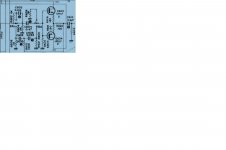Hi all,
I have a preamp in hand (Nikko Beta III) that I recently updated all the electrolytics with Nichicon HE and Silmics. Problem was that it had some roughness/harshness/glare in the upper mids and lower treble region, making vocals sound metallic. Since I knew that the Beta III was supposed to be a good preamp, I decided to find out which stage contributed to the sound. I removed the tone control line nfb first. Gain dropped, but it still had the harshness. I then bypassed the final output stage which looks like it is push pull Class AB or B stage. This stage has been implemented after a rumble filter in the preamp. After bypassing this stage, the issue I had went away. I am a total amateur at this, understand some BJT circuits, but JFETS is a different game to me.
Can someone tell me if the attached schematic is indeed Class B or point me to a possible issue that arise in this stage? Would high crossover distortion be the issue?
The full schematic is available for d/l at hifiengine, a wonderful resource.
Please help, I'd really appreciate your comments.
I have a preamp in hand (Nikko Beta III) that I recently updated all the electrolytics with Nichicon HE and Silmics. Problem was that it had some roughness/harshness/glare in the upper mids and lower treble region, making vocals sound metallic. Since I knew that the Beta III was supposed to be a good preamp, I decided to find out which stage contributed to the sound. I removed the tone control line nfb first. Gain dropped, but it still had the harshness. I then bypassed the final output stage which looks like it is push pull Class AB or B stage. This stage has been implemented after a rumble filter in the preamp. After bypassing this stage, the issue I had went away. I am a total amateur at this, understand some BJT circuits, but JFETS is a different game to me.
Can someone tell me if the attached schematic is indeed Class B or point me to a possible issue that arise in this stage? Would high crossover distortion be the issue?
The full schematic is available for d/l at hifiengine, a wonderful resource.
Please help, I'd really appreciate your comments.
Attachments
If you measure the DC voltage across the source resistors you will know the bias current in the stage. That then tells you the max output current it can deliver in class A. It now depends on the load how much signal level it can deliver in class A.
Example: if you measure 1.8V across R616 giving a bias current of 10mA, the class A Iout is 20mA peak to peak or 7mA RMS. In a 600 ohms load this will be 4.2V RMS, in a 1k load 7V RMS etc.
jan didden
Example: if you measure 1.8V across R616 giving a bias current of 10mA, the class A Iout is 20mA peak to peak or 7mA RMS. In a 600 ohms load this will be 4.2V RMS, in a 1k load 7V RMS etc.
jan didden
I jumpered the output section out by desoldering/lifting the legs of C604 and C610, on the input and output sides respectively.
Thanks Jan, that helps a lot, so it is Class AB. I still can't get over how good it sounds now, with the output stage out of the way. Very unscientific, I know, but I do hear a big in-your-face difference.
Thanks Jan, that helps a lot, so it is Class AB. I still can't get over how good it sounds now, with the output stage out of the way. Very unscientific, I know, but I do hear a big in-your-face difference.
I'd be more suspicious of the caps themselves over the jfet biasing... although i suppose it could be an issue. One idea might be to lower the voltage on the top of the jfets, and run then harder, higher current. You could consider paralleling jfets too... keep the thing in class A.
What is the rating on the jfets?? They might be a bit anemic in a single pair which is why the bias is apparently turned down, so as to not over current/heat them. Just an idea.
_-_-bear
What is the rating on the jfets?? They might be a bit anemic in a single pair which is why the bias is apparently turned down, so as to not over current/heat them. Just an idea.
_-_-bear
All the other stages preceding this push pull stage are single ended Class A. That includes the phono section and the line stage. I was thinking instead of modifying it by adding parallel JFETS, maybe I should do a DCB1, all I need is to buffer the output of the volume control. The volume control is typical of the day, it has a pot at the input and one at the output of the line stage with a total of 4 sections for the two channels.
Anyone know what the overload characteristic of a DCB1 (the Salas version) is?
Anyone know what the overload characteristic of a DCB1 (the Salas version) is?
- Status
- This old topic is closed. If you want to reopen this topic, contact a moderator using the "Report Post" button.
